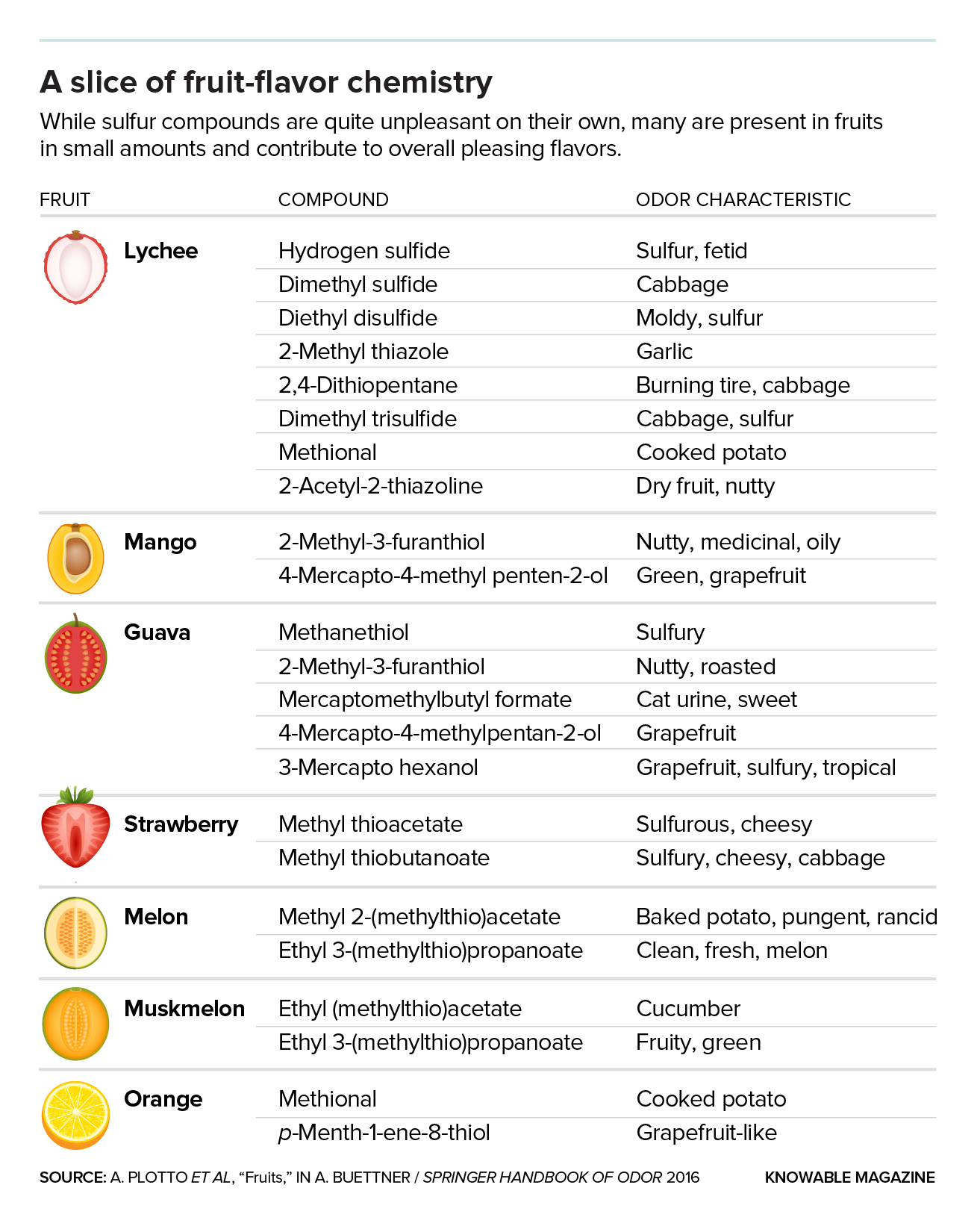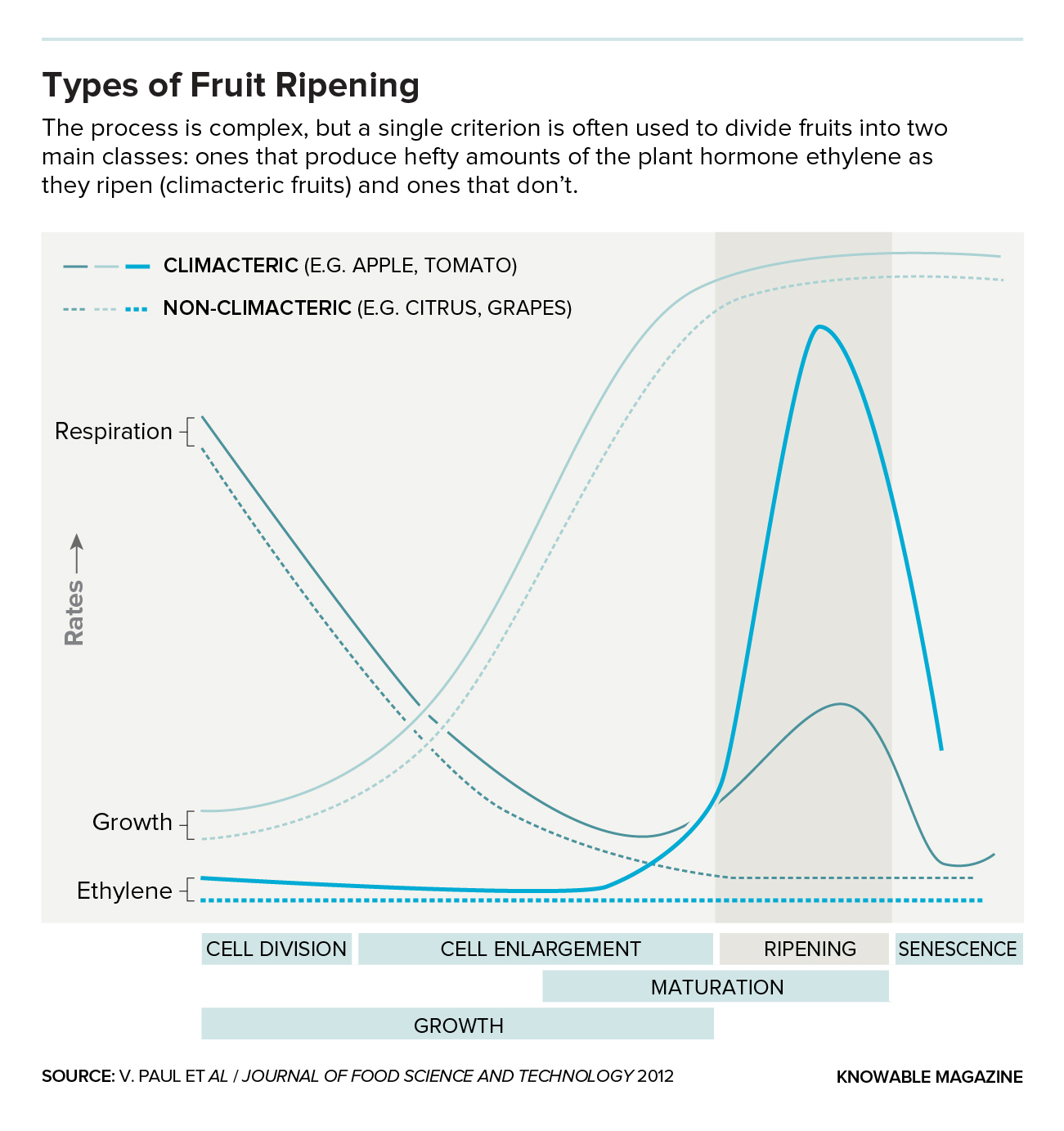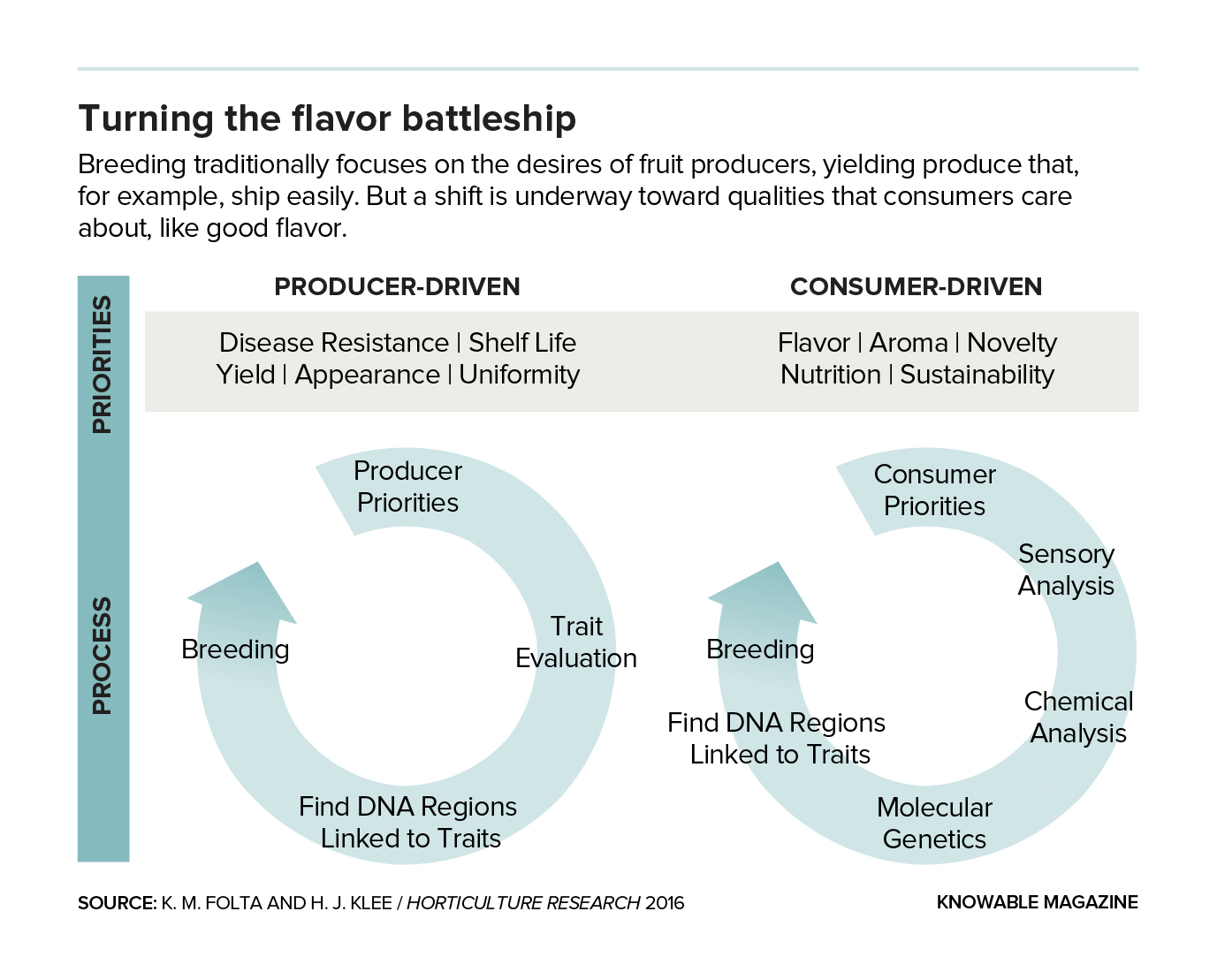If you’re lucky, you’ve tasted a perfectly ripe fruit — a sublime peach, perhaps, or a buttery avocado. But odds are most of the fruit you’ve eaten tastes more like wet cardboard. While plant breeders have mastered growing large, perfect-looking fruits that resist decay, ship easily and are available year-round, flavor has fallen by the wayside.
That’s starting to change. Amid growing consumer interest in sustainable farming and good food, researchers are delving into the complex biochemistry and genetics of fruit flavor with renewed zest. Here are some basic facts about fruit, how it ripens, why much of it tastes so bland — and how scientists are trying to reclaim lost flavors.
What is fruit and how is it made?
Botanically speaking, fruits are mature, ripened ovaries containing seeds. These seed suitcases can be dry, like a pea pod, or fleshy, like an apple or tomato. A fleshy fruit, from the plant’s point of view, is a fee-for-service: a nutritious meal offered to an animal in exchange for dispersing the seeds inside.
Plants spend most of their lives trying not to be eaten, so creating ripe fruit whose only purpose is to be eaten is a dramatic about-face in survival strategy. The plant must shut down defense mechanisms that remain active in the rest of the plant. It must turn on machinery that makes the fruit — and only the fruit — worth eating. “Go away, there’s nothing to see here” becomes “I look and smell delicious. Come and get me!”

This transition from unattractive to attractive entails a tightly coordinated set of biochemical and physiological processes that rivals the changes undergone by a child at puberty. Cells divide and enlarge, starches turn to sugars, green gives way to more conspicuous, vibrant colors that might attract the attention of an animal disperser. Levels of distinctive aromatic compounds steadily rise.
The chemical medley almost always includes compounds called esters, which impart a general fruity quality, says Anne Plotto, a plant physiologist with the U.S. Department of Agriculture’s Agricultural Research Service in Fort Pierce, Fla. (Esters also give a fruity note to cosmetics and artificially flavored foods.) Major physical and textural modifications kick in, turning a tough fruit tender — in tomatoes, more than 50 genes related to cell-wall architecture can be involved in ripening.
This highly orchestrated progression culminates in a period of peak attraction. Then, decay sets in. This stage of self-destruction, called senescence, comes for all fleshy fruits, ensuring that seeds are released even if the fruit is never eaten.
What sets it all off?
The gas ethylene — aka the ripening hormone — is a master manipulator of these myriad processes. If you’ve ever ripened a piece of fruit by sticking it in a paper bag with a banana, you’ve taken advantage of ethylene. A natural plant hormone, it is a simple molecule (C2H4) also found in smoke and vehicle exhaust. In many plants, ethylene stimulates both flowering and fruit ripening, controlling qualities such as color, aroma and texture.
But the gas has profound effects on many other aspects of plant development; in fact, it’s also known as the stress or aging hormone. Ethylene can stunt root and stem growth, and it triggers a physiological cascade that leads to amputation, or abscission, should part of a plant become damaged. (An early insight into ethylene’s effects on plants came at the turn of the 20th century when scientists noticed that gas leaking from street lamps stunted the growth of nearby trees and made them drop their leaves.)

Because of ethylene’s dramatic and diverse effects, it is both a friend and foe to those in the produce industry. Fruit distributors have gotten very good at using ethylene to control ripening in certain fruits like bananas; there are also tricks for thwarting ethylene’s effects when they’re not wanted. However, many fruits, such as grapes, don’t just ripen on demand when exposed to the gas. Figuring out how those fruits ripen, and how to manipulate the process, remains a rich field of study.
Ethylene in action
People who deal with fruits, whether produce distributors or plant physiologists, typically divide them into two categories: those that ripen in response to ethylene and those that do not. While this split is an oversimplification, it has a basis in biology and it serves as a practical guide for determining how to handle fruits before they reach the consumer.
Fruits that respond to ethylene are called “climacteric” and include apples, avocados, bananas, figs, mangoes, papayas, peaches, pears and tomatoes. These fruits exhibit a burst in respiration (basically, heavy breathing, called the “climacteric rise”) along with a spike in ethylene production as they ripen. The surge of ethylene, along with other plant hormones, spurs gene and enzyme activity that makes fruit attractive, sweet and delicious.
Generally speaking, climacteric fruits continue to ripen after they’ve been picked, and the ripening process can be manipulated by exposing them to ethylene. (The banana-in-the-bag trick works only with climacteric fruits, which are responding to ethylene released by the banana.)
“It’s as if the fruits are put into hibernation. They’re in a state of suspended animation.”
James GiovannoniNon-climacteric fruits, the other class, don’t exhibit the climacteric rise and coincident spike in ethylene production and in many respects are immune to ethylene’s charms. These include citrus, grapes, cherries, pineapples and many berries. They don’t ripen after picking and most won’t get sweet and tender when exposed to ethylene. The gas may have minor effects — ethylene will “de-green” citrus fruits, for example, turning them their ripe colors, but it doesn’t ripen the rest of the fruit.
The ethylene effect is handy for growers, producers, distributors and retailers: The last thing they need is fruit bursting with prime ripeness before it reaches consumers. Produce suppliers can pick bananas, tomatoes, pears and a handful of other fruits a week or two early, when they’re not quite ripe but are firm and easily transported. Distributors can then ship the fruits or store them in large warehouses where temperature and oxygen and carbon dioxide levels are precisely controlled, stalling further ripening. “It’s as if the fruits are put into hibernation,” says Cornell University’s James Giovannoni, also a plant molecular biologist with the USDA. “They’re in a state of suspended animation.”
These stalling techniques, along with breeding efforts that have led to early-, middle- and late-season varieties, give us various seasonal fruits practically year-round. (Apples, for example are always picked in summer or fall, yet they are almost always available). With the appropriate fruit and at the appropriate time (right before reaching the consumer), a distributor may expose the fruits to ethylene, kicking them back into ripening gear. (This approach, on rare occasion, goes very wrong. Ethylene is flammable and large explosions in fruit warehouses have killed people).
In supermarkets, produce aisles are often arranged with ethylene in mind. The gas can spur decay in non-fruit parts of a plant, so asparagus, lettuce and other greens are typically kept away from fruits that emit ethylene. And there’s an entire industry devoted to technologies that help maintain low-ethylene, low-oxygen atmospheres inside the plastic bags and clamshell containers that hold fresh produce.
So where’s the taste?
In the last 50 years, the primary focus of plant breeding has been on creation of disease-free, high-yield plants that produce uniformly shaped fruits that can be shipped, stored and packaged for sale whether it be in January or June. Gene variants that delay ripening, for example, have been bred into some fruits, while the genetics of flavor, aroma and nutrition — each complex in its own right — have been neglected.
Farmers don’t get paid for taste, they get paid per pound, notes Klee.
This sorry state of fruit taste also has much to do with you, dear consumer. With fewer people farming or even familiar with how food is grown, “many people don’t really know what a fruit could or should taste like,” says Giovannoni. And when consumers do say that they want better flavor, they also want today’s widely available, inexpensive fruit. “Where better flavor is available, it generally costs more,” says molecular biologist and tomato expert Harry Klee of the University of Florida in Gainesville. “Most are not willing to pay that extra price.”
Farmers don’t get paid for taste, they get paid per pound, notes Klee. Only when consumers demand good taste — and are willing to pay for it — will they see better-tasting fruit in the produce aisle, he says.
Is there hope for the future of fruit?
A growing interest by consumers and scientists is spurring efforts to bring flavor back. Some researchers are now starting with consumer desires rather than producers’ practices, exploring what tastes good and then working backwards to unravel the genetics and biochemistry that produce better flavors with hopes of breeding them into hardy lines.

Sensory panels that test people’s taste preferences have gotten more sophisticated in the last decade, generating sometimes counterintuitive results that may expand the flavor horizon. The compound isovaleric acid, for example, smells like sweaty socks on its own, but it enhances the perception of sweetness in concert with other volatiles in tomatoes, says sensory scientist Linda Bartoshuk of the University of Florida in Gainesville. In strawberries, more than 360 different compounds are thought to contribute to aroma, but recent testing by Bartoshuk and colleagues suggests that only about 30 contribute to essential strawberryness. Efforts to increase the quantities of some of these volatiles via breeding could ensure sweet strawberries even as sugar content declines during the growing season.
The focus on uniformly shaped fruits has come at the expense of taste, and only one of those qualities should matter, argue those in the “ugly produce” movement.
Klee and Giovannoni are involved in a major effort to unearth versions of genes in wild tomato plants that might impart exceptional flavor, nutritional content and shelf life. The research, which can point breeders toward good candidate genes in other fruits, has identified many promising possibilities. But getting these wild genes bred into existing tomato lines, already imbued with desirable traits like disease resistance, is no small thing, says Giovannoni.
Beyond the world of plant breeding, others are working to change people’s expectations about how produce should look. The focus on uniformly shaped fruits has come at the expense of taste, and only one of those qualities should matter, argue those in the “ugly produce” movement. While their aim is to save less-than-perfect produce from the landfill, the spread of less-picky attitudes could help bring taste to the forefront. Several big supermarket chains have committed to selling knobby strawberries, doubled cherries and curly cucumbers in some stores.
This effort, aimed at the sustainability-minded, is a good reminder to consumers that good taste comes in all kinds of packages — but you do have to ask for it.




